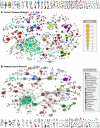Systems biology for molecular life sciences and its impact in biomedicine
- PMID: 22903296
- PMCID: PMC11113420
- DOI: 10.1007/s00018-012-1109-z
Systems biology for molecular life sciences and its impact in biomedicine
Erratum in
- Cell Mol Life Sci. 2013 Sep;70(18):3475-80
Abstract
Modern systems biology is already contributing to a radical transformation of molecular life sciences and biomedicine, and it is expected to have a real impact in the clinical setting in the next years. In this review, the emergence of systems biology is contextualized with a historic overview, and its present state is depicted. The present and expected future contribution of systems biology to the development of molecular medicine is underscored. Concerning the present situation, this review includes a reflection on the "inflation" of biological data and the urgent need for tools and procedures to make hidden information emerge. Descriptions of the impact of networks and models and the available resources and tools for applying them in systems biology approaches to molecular medicine are provided as well. The actual current impact of systems biology in molecular medicine is illustrated, reviewing two cases, namely, those of systems pharmacology and cancer systems biology. Finally, some of the expected contributions of systems biology to the immediate future of molecular medicine are commented.
Conflict of interest statement
The author declares that there is no conflict of interest.
Figures








References
-
- Loeb J. The mechanistic conception of life. Cambridge: Bellknap Press; 1912.
-
- Smuts JC. Holism and evolution. New York: Viking Press; 1926.
-
- Corning P. The re-emergence of “emergence”. A venerable concept in search of a theory. Complexity. 2002;7:18–30.
-
- Vernadsky V. The Biosphere [in Russian] St. Petersburg: Nauch; 1926.
Publication types
MeSH terms
LinkOut - more resources
Full Text Sources

